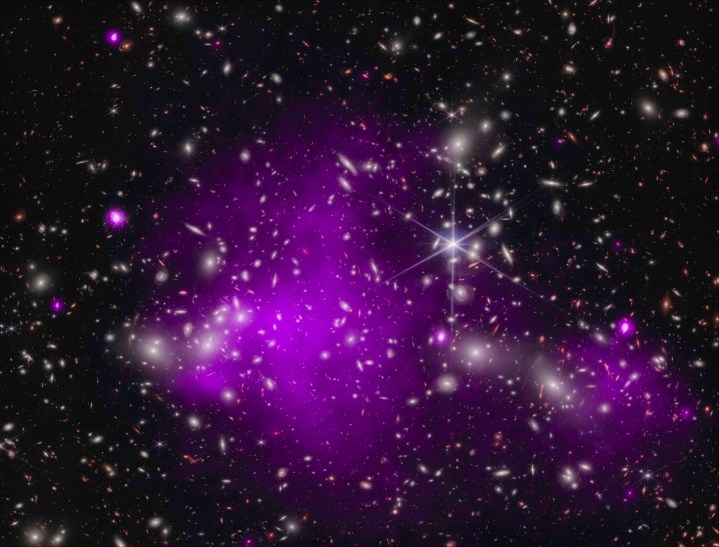Astronomers recently discovered the most distant black hole ever observed in the X-ray wavelength, and it has some unusual properties that could help uncover the mysteries of how the largest black holes form.
Within the center of most galaxies lies a supermassive black hole, which is hundreds of thousands or even millions or billions of times the mass of our sun. These huge black holes are thought to be related to the way in which galaxies form, but this relationship isn’t clear — and how exactly supermassive black holes grow so massive is also an open question.
The recently discovered black hole, in the galaxy UHZ1 located an incredible 13.2 billion light-years away, is a young one and its mass is currently similar to that of the galaxy in which it resides. It is visible thanks to the gravitational lensing effect of the galaxy cluster Abell 2744, shown below, which has such huge mass that it bends spacetime and magnifies the distant galaxy to make it observable. It was located using the James Webb Space Telescope and then observed using then Chandra X-Ray Observatory.

“We needed Webb to find this remarkably distant galaxy and Chandra to find its supermassive black hole,” said lead author of the research, Akos Bogdan of the Center for Astrophysics | Harvard & Smithsonian, in a statement. “We also took advantage of a cosmic magnifying glass that boosted the amount of light we detected.”
This black hole seems to have been born massive, which allowed it to reach a large mass even at a young age. “There are physical limits on how quickly black holes can grow once they’ve formed, but ones that are born more massive have a head start. It’s like planting a sapling, which takes less time to grow into a full-size tree than if you started with only a seed,” explained another of the researchers, Andy Goulding of Princeton University.
The black hole is located within a pocket of superheated gas that is giving off X-rays, suggesting that it could have formed from the collapse of a cloud of gas. “We think that this is the first detection of an ‘Outsize Black Hole’ and the best evidence yet obtained that some black holes form from massive clouds of gas,” said fellow researcher Priyamvada Natarajan of Yale University. “For the first time, we are seeing a brief stage where a supermassive black hole weighs about as much as the stars in its galaxy, before it falls behind.”
The research is published in the journal Nature Astronomy, with other results published in Astrophysical Journal Letters.
Editors' Recommendations
- See incredible time lapses of two of space’s most famous objects
- SpaceX all set for a record-breaking rocket launch on Friday
- SpaceX is gearing up for a record-breaking rocket flight
- Scientists want your help to search for black holes
- Four telescopes work together to create a gorgeous image of a supernova remnant




